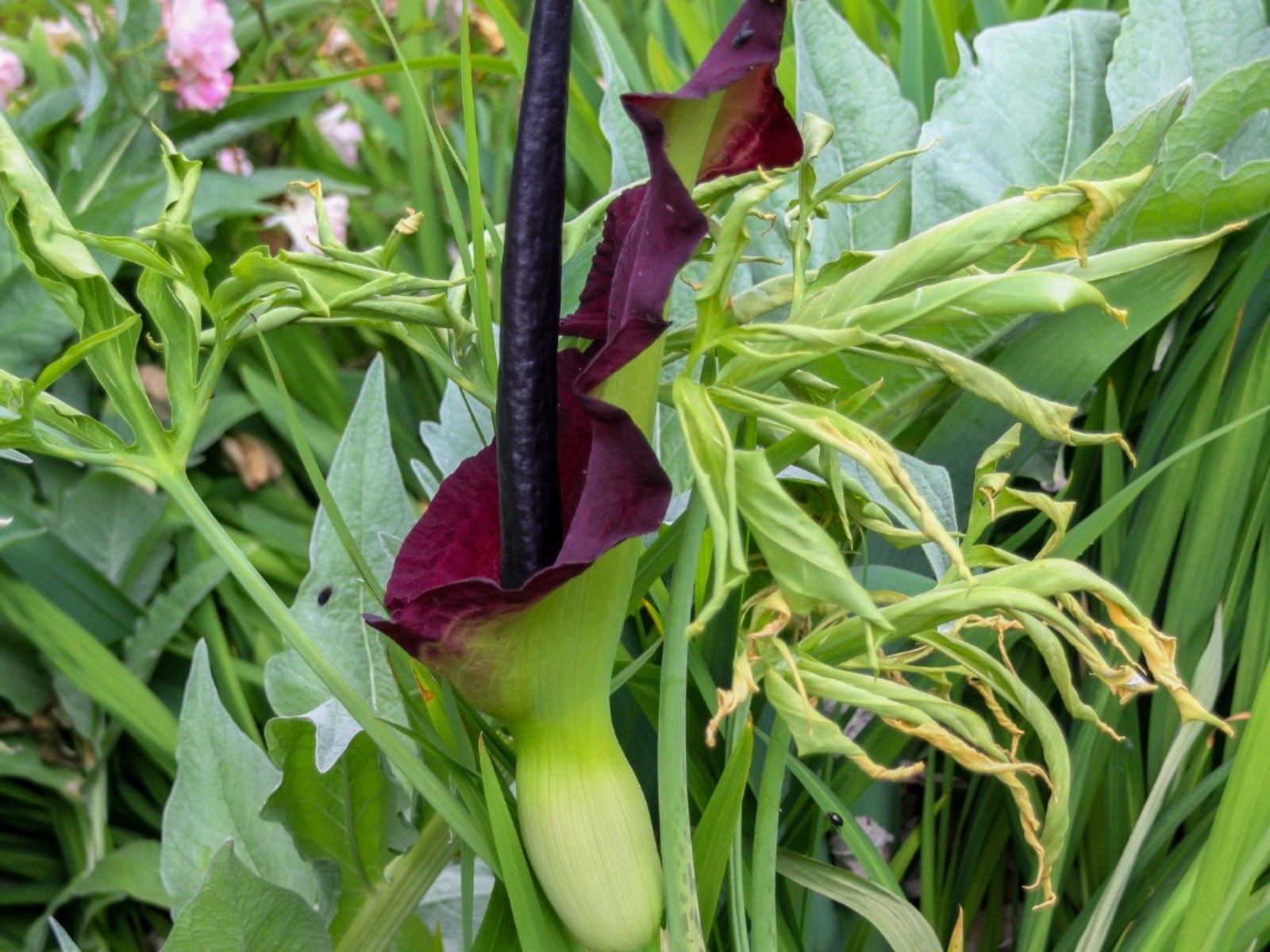What Is A Dragon Arum Flower: Tips On Growing Dragon Arums


Dark and exotic plants provide drama and excitement to local flora. Dragon arum flower is one such specimen. The amazing form and deep intoxicating color are second only to its astounding stench during its peak. The plant actually does very well in cooler temperate climates where growing dragon arums only require minimum water and bright shade. Purchase a couple of tubers and learn how to grow a dragon arum so you can experience the exotic beauty of this plant.
What is Dragon Arum Lily?
Dragon arum lily (Dracunculus vulgaris) is also called voodoo lily, snake lily, stink lily, and many more colorful monikers. With the spadix nestled in the center, it's no wonder the plants are called amorphallus. The plant is a deciduous tuber which produces large-fingered aroid leaves of glossy light green. The leaves perch atop thick stalks decorated with a snakeskin pattern and are set in groups of three. The plant begins to sprout in March, and soon the leaves are rising a foot (30 cm.) above the base of the plant. The spadex and spathe protect the tiny flowers set deeply inside this flower-shaped organ. The spathe erupts and unfurls, cradling the deep purplish-black spadix. The spathe is a rich maroon color nearly 24 inches (60 cm.) in diameter.
How to Grow a Dragon Arum
The breathless gardener will stand in awe of this unique plant. Dragon arum flower may look like a pampered tropical lily but it is actually native to the Balkans, Greece, Crete, the Aegean's, and temperate to cool parts of the Mediterranean. As such, it can withstand and thrive in United States Department of Agriculture zones 5 to 8. In spite of the rich and colorful names, the plant is rather pedestrian in its likes. The stunning flowers start from a tuber that is planted at least 4 inches (10 cm.) below the surface of the soil in fall. Make sure the soil is well draining and loose. You can choose a semi-shady location or a sunny one, but in full sun they will need more water. Give them average water so the soil stays moderately damp several inches (7.5 cm.) down, but make sure the area isn't soggy, as this will likely rot the tuber. In early spring, the plant begins to coil up from the earth in a cone shape. Flowers come at the end of summer and then the plant dies back in fall.
Dragon Arum Care
These plants grow wild in their native regions. You can find them near ponds, rivers and dappled forest edges. They are remarkably resilient and will come back again year after year, either from spreading tubers or from seed. In fact, if you water the plant regularly, it will need little additional dragon arum care. The “flower” gives off a noxious odor when ripe for up to 3 days, so plant it at the edge of the garden and away from open windows and doors. To prevent seedlings from popping up everywhere, gather up the large red seeds before they plant themselves. Use gloves, as the plant is toxic. Or conversely, let this shocking-in-every-way plant take over a corner of the garden and invite friends in to gaze in wonder at this fascinating lily and, perhaps, harvest one for themselves.
Gardening tips, videos, info and more delivered right to your inbox!
Sign up for the Gardening Know How newsletter today and receive a free copy of our e-book "How to Grow Delicious Tomatoes".

Bonnie Grant is a professional landscaper with a Certification in Urban Gardening. She has been gardening and writing for 15 years. A former professional chef, she has a passion for edible landscaping.
-
 Looking For Plants To Give You The Soft And Fuzzies? Try These 5 Fuzzy Leaf Plant Options
Looking For Plants To Give You The Soft And Fuzzies? Try These 5 Fuzzy Leaf Plant OptionsLovers of texture, drama, silver foliage and tactile plants will adore these special sensory garden additions. These fuzzy leaf plant options will leave you all aglow
By Susan Albert
-
 Get Ready For A Summer Of Hummers! Grow These Full Sun Hummingbird Plants and Flowers
Get Ready For A Summer Of Hummers! Grow These Full Sun Hummingbird Plants and FlowersIf you’re lucky enough to enjoy a sunny backyard, make sure you are maxing out on your pollinator opportunities and grow these full sun hummingbird plants and flowers
By Tonya Barnett